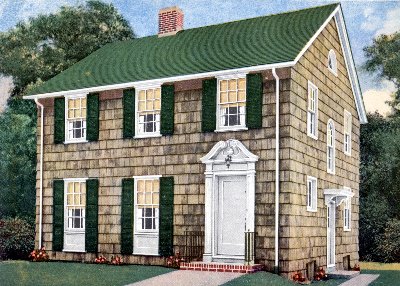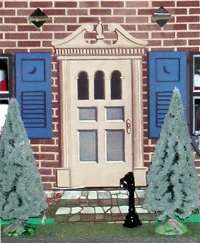home page 1890s 1900-1920 part 1: 1920s part 2: late 1920s part 2: 1930s 1940s 1950s part 1: 1960-1990 part 2: 1960-1990 Although times were tough for many people in Canada and the United
Sates in the 1930s due to the Great Depression, they were at least peaceful
In tandem with commercially made products, home-made dollhouses
continued to be created by doting fathers and grandfathers with home-made furnishings (right) such as curtains, rugs, bedding, and even furniture supplied by
doting mother and
A number of American dollhouse or dollhouse furnishings manufacturers, which began in the 1920s, continued strongly in the '30s such as Tootsietoy (discussed in part1:1920s); Arcade, Hubley and Kilgore (the latter three are discussed in part 2: late 1920s); Converse (Realy Truly furniture); Tynietoy; and Schoenhut. Others such as Strombecker (the latter 4 firms are discussed in part 2 of the 1930s) took off in the '30s and grew steadily in the 1940s. One of the interesting aspects of all their products is that they are not made from plastic, which belongs to a later period. One of the styles in architecture that was particularly
important in this decade -- although it also appeared in the 1920s and 1940s -- was Half
Timber, also known as Tudor or Elizabethan. It may dominate a house,
especially in British examples, or become a token decoration, particularly in North
America. With its reliance on the past, it is yet another manifestation of the revival
styles which intrigued the Victorians during the 19th century. This historicism was
rejected by avant garde architects such as Peter Behrens of Germany and the Bauhaus
architects, some of whom (for example Walter Gropius) emigrated to the USA around 1940.
Not surprisingly, dollhouse design reflected the conservative tastes of the middle-class
families who tended to sentimentalize the past. One could argue, however, that the wood
framing revealed on the exterior of Tudor houses met the modernist criteria of honesty in
materials and construction.
Late medieval house with half timbering in Lancashire, England, from Joseph Nash's The Mansions of England in the Olden Time, 1839-39. This sort of grand house inspired the more elaborate versions of Tri-ang dollhouses.
The origins of these buildings in late medieval Britain may have contributed heavily to its popularity there in the 1930s and '40s. The era of truly massive timbers morticed, tenoned and pegged together to support an overhanging upper storey was long since past, and token "timbers" became applied decoration on house fronts -- often restricted to the attic level. In 1928 an American pattern book of residential designs by O'Dell summarized Tudor or Elizabethan Revival houses as "beautiful compositions of shapely architectural forms, varied wall surfaces, projecting casements and rich, decorative detail."
Modern half timber house in Wimbledon, England, illustrated in Decorative Art 1928.
After the First World War, the Tri-ang Company of England evolved out of a rival but related business, namely the George & Joseph Lines Company, which began in the late 19th century under the thistle brand. When Joseph Lines died in 1931, that firm merged with Tri-ang under the latter name. "Tri" as well as the triangle shape represented Joseph's three sons ("L. Bros. Ltd"), William, Walter and Arthur Lines. In the 1920s, it was "Triangtois" replaced by "Tri-ang Toys" in the '30s. The earliest Lines catalogue shows half timbering but restricted to the attic level of houses reminiscent of the Empire style but by 1931 there were "houses of Elizabethan design" which -- despite the historical association -- included integrated garages to accommodate modern vehicles, by this time widespread in the middle-class. Also available were free-standing garages with hinged doors and, above these, a simple half-timber pattern in the gable. In the 1930s, the characteristic Tri-ang metal casement windows with rectangular glazing bars appeared adding life to the houses because they can be swung outwards to allow the inhabitants to peer out and provide glimpses of the interior furnishings to the onlooker. Also adding to the life-like quality was electricity giving a warm glow to the rooms. Plywood and deal (inexpensive solid wood) were the materials found under the finishing coats of paint. Residences with half timbering were characterized in the company's advertisements as country cottages or houses.
Drawing of one of the chimneys from the larger house.
If reproducing to replace a missing chimney, be sure to inscribe the year to avoid future
confusion. Two pieces of dowelling, ½ inch in diameter and painted red, fit into a
2 (actually measures 1.75 in.) x 1 (actually measures .75 in.) inch piece of pine cut 1½
inches long with an inverted V removed in order to straddle the roof. This is painted
cream to match the walls. A thin metal rod inserted into the top of the V fits loosely
into holes in the roof. Some houses (see examples below) did not
have chimney pots (that is the dowelling).
right 1953 left 1939
1953
above & below Lines brothers (Tri-ang) ad for "Old English style" furniture in 1923. See also Barton furniture in the Tudor style from the 1960s (part2: 1960-1990 -- link at top and bottom of page).
1923 ad for Lines Brothers (Tri-ang) furniture
************************************************************************************* Tudor dollhouses from other manufacturers:
When Tudor dollhouses made the leap over the Pond to the United States, the style's English origins were often acknowledged, as in this advertisement of 1947 (from the December issue of Children's Activities) for a fibreboard house by Built-Rite of Indiana. Many of this company's products were introduced in the 1930s under the name of Warren Paper Products. Here, the half timbering is confined to the upper level, as also happens in this house in Kingston, Ontario, Canada, with brick forming the lower main storey. Chimneys tend to be prominent -- ironically at a time when their importance (as related to the fireplaces they serve) as heating devices is insignificant with the triumph in the United States and Canada of central heating via coal furnaces.
Shingles entirely cover this American house illustrated in O'Dell's Home Builder's Catalogue of 1928 as "a beautiful and pure example of Colonial style of architecture." The shutters, small pane windows, brick chimney, gable roof and doorway are reminiscent of the cardboard dollhouse. Colonial style will be examined in the 1940s section of this history of dollhouses -- a time when it was at its peak of popularity in North America. N.B.!! - TO CONTINUE THIS HISTORY, PLEASE CLICK ON PART 2: 1930s |
top of page home page articles on antiques & vintage article on Lundby dollhouses
gallery of images of dollhouses & furnishings
1890s 1900-1920 part 1: 1920s part 2: late 1920s part 2: 1930s 1940s
|
link to REFERENCES on DOLLHOUSES & FURNISHINGS |
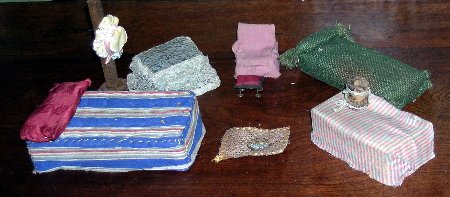 d
and cardboard were the choices for dollhouses. Colourful printed papers were glued over
these cheap materials.
d
and cardboard were the choices for dollhouses. Colourful printed papers were glued over
these cheap materials. 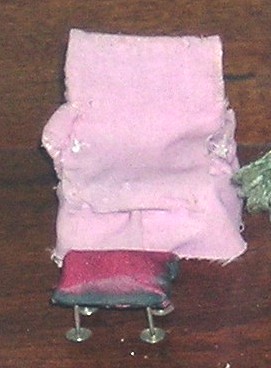 grandmothers or even ambitious children. These might be mingled
with factory made furniture, some of which was very cheap to purchase. Even the simplest
of home-made furnishings are interesting today because the fabric patterns and colours
speak to us of a past that grows ever dimmer in our memories as grandparents and parents
-- who lived through the Dirty Thirties -- pass away in the early 21st century.
Illustrated is a group of American dollhouse items from that period, constructed by sewing
material ranging from lace to green burlap onto "on hand" cardboard boxes formed
from business cards and store boxes The striped mattress is particularly effective
imitating how such mattresses were tacked through. The stool has brass tacks for feet.
grandmothers or even ambitious children. These might be mingled
with factory made furniture, some of which was very cheap to purchase. Even the simplest
of home-made furnishings are interesting today because the fabric patterns and colours
speak to us of a past that grows ever dimmer in our memories as grandparents and parents
-- who lived through the Dirty Thirties -- pass away in the early 21st century.
Illustrated is a group of American dollhouse items from that period, constructed by sewing
material ranging from lace to green burlap onto "on hand" cardboard boxes formed
from business cards and store boxes The striped mattress is particularly effective
imitating how such mattresses were tacked through. The stool has brass tacks for feet. 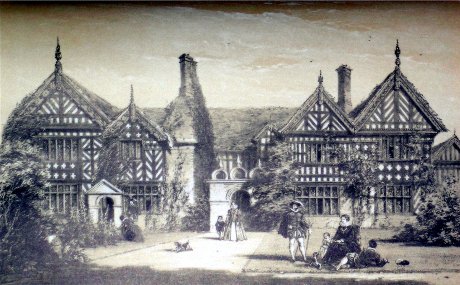
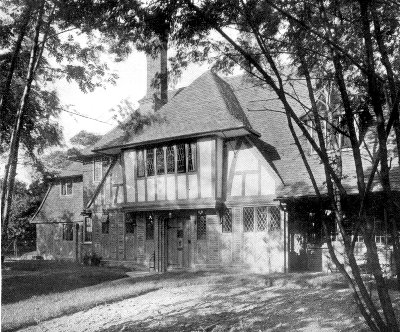
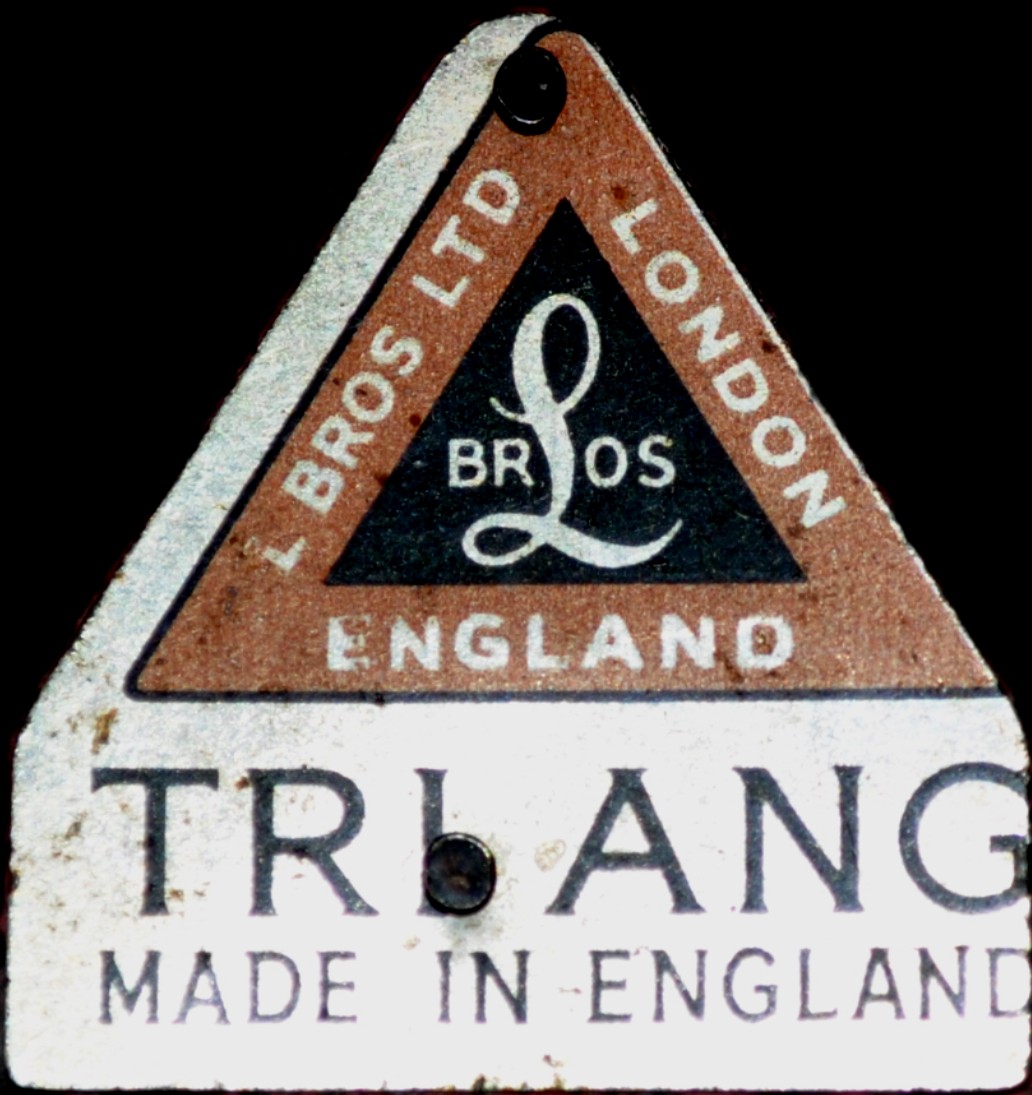
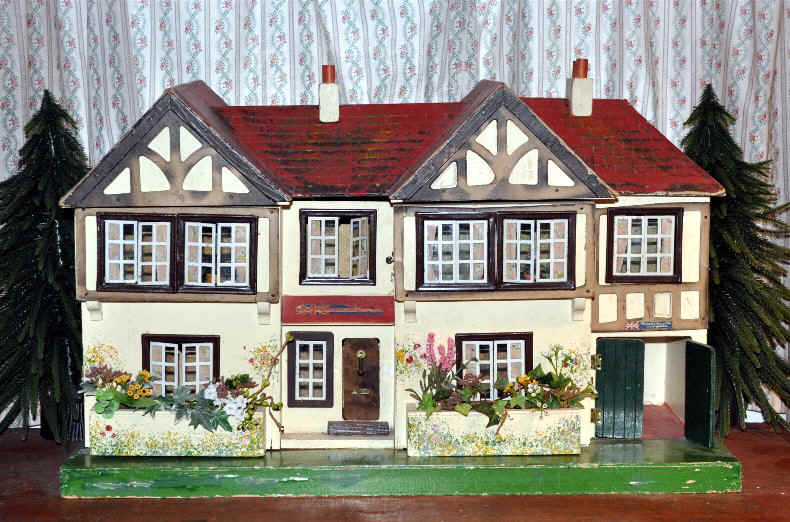
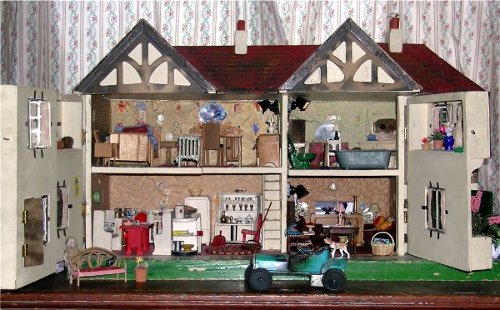
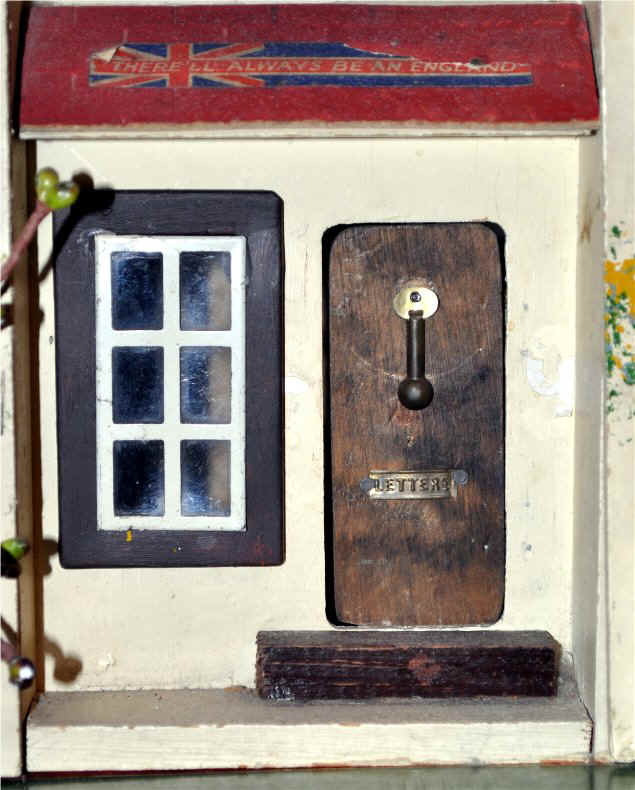 Tri-ang houses from the late
1930s. The large one, used until last year by the descendants of the original owner in
Victoria, British Columbia, Canada, has its original chimneys (see drawing
below), curtains, wallpaper and floor coverings. The unpainted door has a brass
knocker and "Letters" plate. Simple interior staircases were installed the more
expensive models. A hole in the back wall of each room was for electric bulbs. This
particular house is unusual because of the curved timber braces in the pediments or
gables, the extra timbers above the garage, the pairs of curved corbels (usually
right-angle triangles) under the overhanging upper windows and the pair of flower boxes.
The same basic model appeared in a variety of sizes including the one (below)
with a central projecting pediment flanked by upper rooms over a "tiled
sun-porch" and garage. This example, missing its pair of chimneys (look for a hole in
the roof's peak where a metal rod once held a chimney in place), was made without a
staircase. The rooms to each side in the upper storey are somewhat awkward to access. A
door leads from the main-floor room into the arched open room, which made an attractive
outdoors sitting area, originally lined on the back wall with a bench. Lacking a front
door, one entered the house through the loggia. Daubs of paint form flowering shrubs and
roses on the exterior of the lower centre room. This particular house remained popular
through to the 1950s, during which decade some of the Tri-ang houses were made with metal
fronts and plastic windows. Often missing are the ramp for the garage and set of exterior
stairs, one version of which is shown below although the usual 4 "dummy shrubs"
are missing (some houses, however, were originally sold without any steps or ramps).
Tri-ang houses from the late
1930s. The large one, used until last year by the descendants of the original owner in
Victoria, British Columbia, Canada, has its original chimneys (see drawing
below), curtains, wallpaper and floor coverings. The unpainted door has a brass
knocker and "Letters" plate. Simple interior staircases were installed the more
expensive models. A hole in the back wall of each room was for electric bulbs. This
particular house is unusual because of the curved timber braces in the pediments or
gables, the extra timbers above the garage, the pairs of curved corbels (usually
right-angle triangles) under the overhanging upper windows and the pair of flower boxes.
The same basic model appeared in a variety of sizes including the one (below)
with a central projecting pediment flanked by upper rooms over a "tiled
sun-porch" and garage. This example, missing its pair of chimneys (look for a hole in
the roof's peak where a metal rod once held a chimney in place), was made without a
staircase. The rooms to each side in the upper storey are somewhat awkward to access. A
door leads from the main-floor room into the arched open room, which made an attractive
outdoors sitting area, originally lined on the back wall with a bench. Lacking a front
door, one entered the house through the loggia. Daubs of paint form flowering shrubs and
roses on the exterior of the lower centre room. This particular house remained popular
through to the 1950s, during which decade some of the Tri-ang houses were made with metal
fronts and plastic windows. Often missing are the ramp for the garage and set of exterior
stairs, one version of which is shown below although the usual 4 "dummy shrubs"
are missing (some houses, however, were originally sold without any steps or ramps). 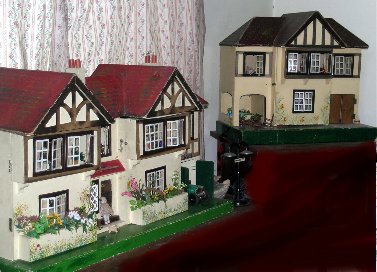
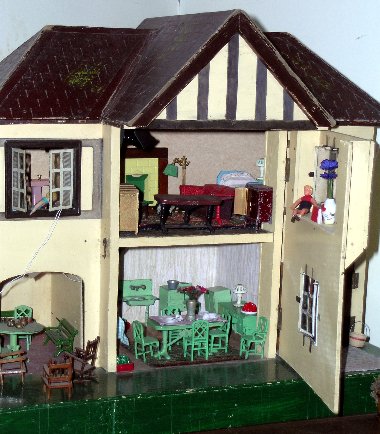

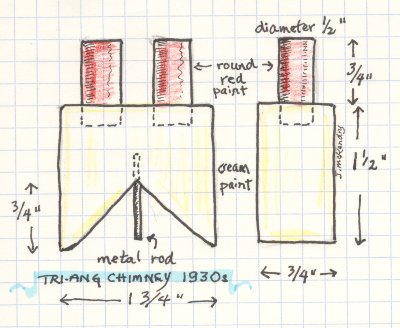
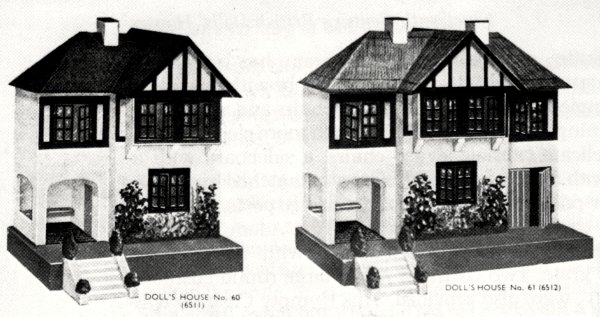
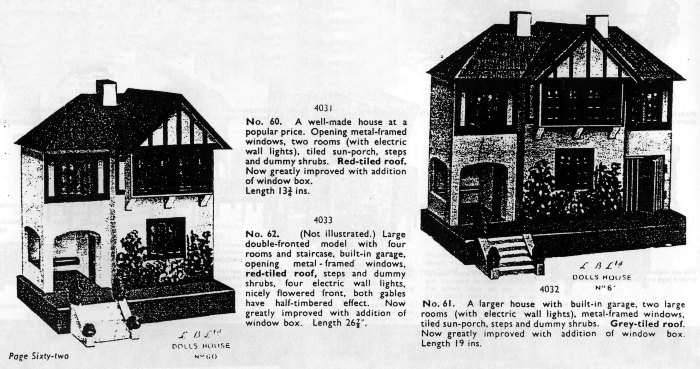
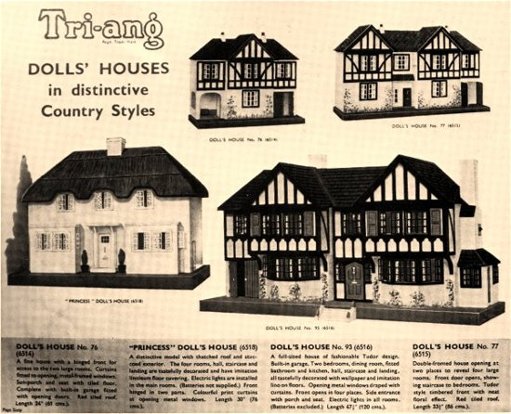
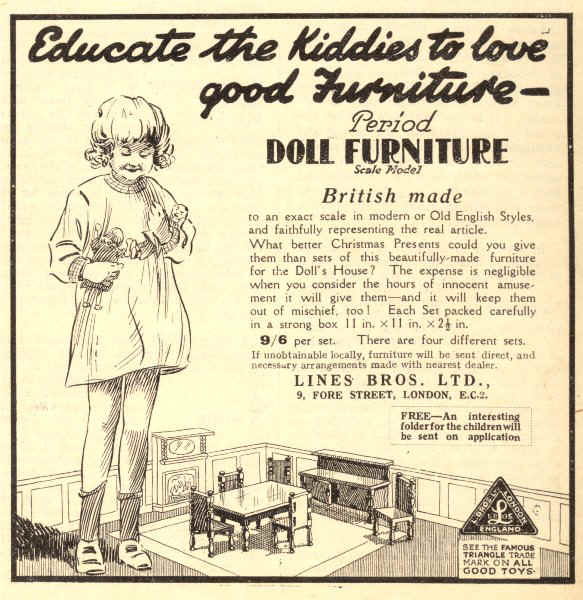
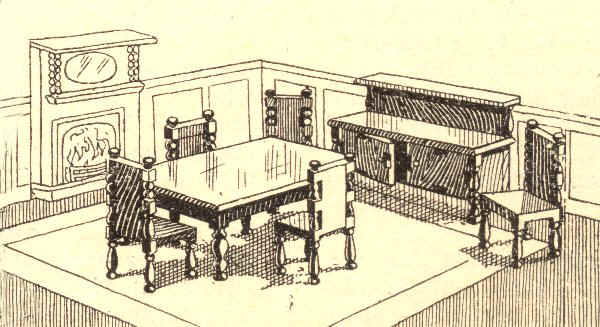
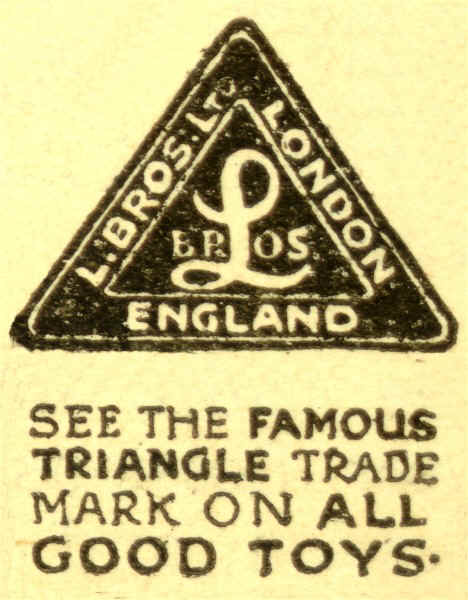
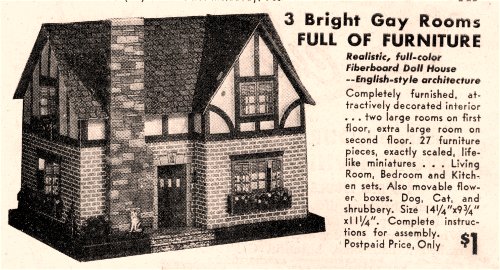
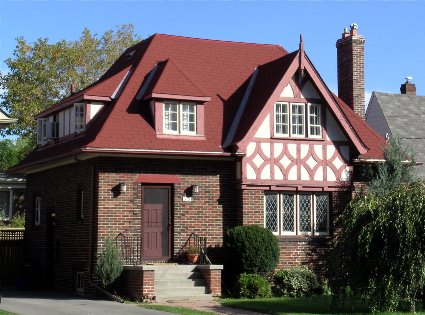
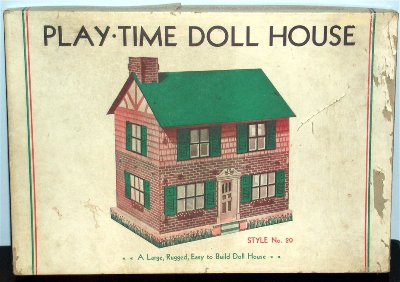
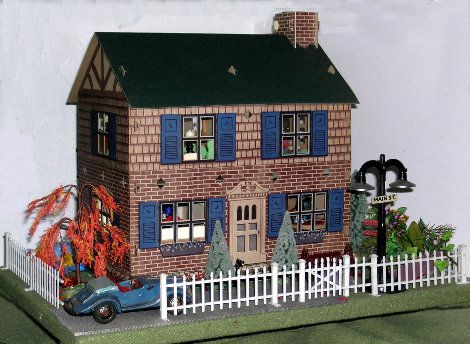
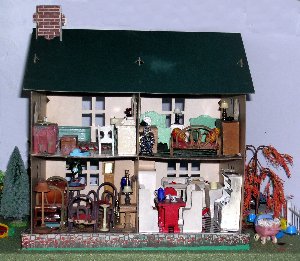 In this Warren Paper Products Company
cardboard "Play-Time Doll House" half timbering has shrunk into the end gables;
the mid-1930s house is shingled on the upper story while bricks form the lower. The 4-room
interior was produced devoid of decoration but modern floors of wood or tiles can be cut
and loosely laid without spoiling the historic integrity. The tabs holding the walls,
roof, chimney and floors together (they disassemble and lie flat in the box for shipping)
are distracting.
In this Warren Paper Products Company
cardboard "Play-Time Doll House" half timbering has shrunk into the end gables;
the mid-1930s house is shingled on the upper story while bricks form the lower. The 4-room
interior was produced devoid of decoration but modern floors of wood or tiles can be cut
and loosely laid without spoiling the historic integrity. The tabs holding the walls,
roof, chimney and floors together (they disassemble and lie flat in the box for shipping)
are distracting.